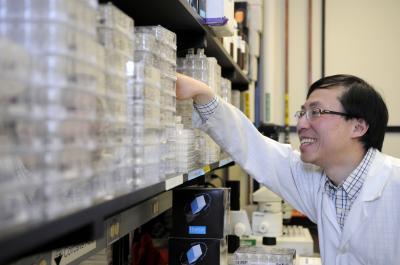Clostridium difficile is a health problem that affects hundreds of thousands of patients and costs $10 billion to $20 billion every year in North America. Researchers from the University of Calgary and the National Research Council of Canada say they are gaining a deeper understanding of this disease and are closer to developing a novel treatment using antibodies from llamas.
"We have found that relatively simple antibodies can interfere with the disease-causing toxins from C. difficile," says paper co-author Dr. Kenneth Ng, an associate professor of biological sciences at the University of Calgary and principal investigator of the Alberta Ingenuity Centre for Carbohydrate Science. "This discovery moves us a step closer to understanding how to neutralize the toxins and to create novel treatments for the disease." His research is part of a paper published today in the print issue of the Journal of Biological Chemistry.
Approximately two percent of all patients admitted to hospital may be infected by C. difficile, which thrives when healthy bacteria in the gut are weakened by antibiotics, thus allowing spores from Clostridium to germinate and colonize the large intestine.
"This research is significant because C. difficile is an increasing heath care problem and many people may experience multiple infections," says Dr. Glen Armstrong, head of the Department of Microbiology, Immunology, and Infectious Diseases in the Faculty of Medicine at the University of Calgary. "The current treatments are becoming less effective and C. difficile is developing resistance to conventional antibiotics. This research promises to provide a much-needed alternate treatment option that will overcome the failings of conventional antibiotics."
C. difficile produces two toxins -- toxin A (TcdA) and toxin B (TcdB) -- which cause damage to intestinal cells by binding to carbohydrates on the cell surface and disrupting cell functions such as adhesion. The new research shows that what's known as single-domain antibodies bind to the C. difficile toxins with high affinity and interfere with the toxins' ability to damage cells.

Kenneth Ng, an assistant biological sciences professor at the University of Calgary, is researching a treatment for Clostridium difficile that uses antibodies from camels and llamas.
(Photo Credit: Riley Brandt, University of Calgary)
"Llamas have normal antibodies like our own, but they have also developed a second type of antibody with a simpler structure. It is this simpler structure that allows us to make modifications and perform many detailed studies that are not easily done with other types of antibodies," says Ng. "The unique characteristics of these single-domain antibodies provide an attractive approach for developing new treatments for C. difficile."
These single-domain antibodies were discovered in 1993 in camelids, which include llamas and camels. Camelids produce conventional antibodies found in all mammals as well as heavy-chain antibodies from which single-domain antibodies are derived. These single-chain antibodies are 10 times smaller than those found in humans and can be more readily engineered into a drug.
Dr. Jamshid Tanha, the corresponding author of the study from the National Research Council in Ottawa says that understanding how camelid antibodies work will ultimately allow researchers to develop a new treatment for this important disease and potentially others.
"We are currently working with Dr. Ng's group to determine why these antibodies are successful," says Tanha.
Currently, licensing opportunities with biotechnology firms are being explored.
Source: University of Calgary